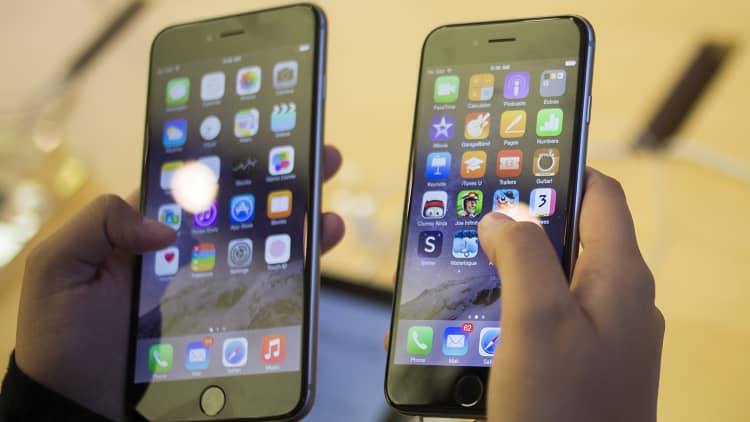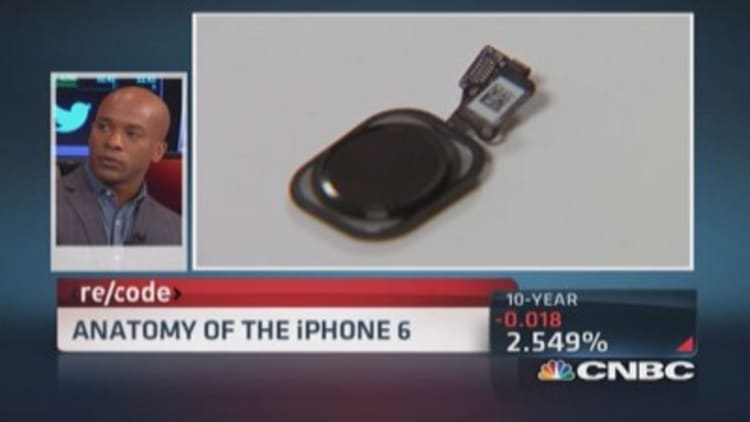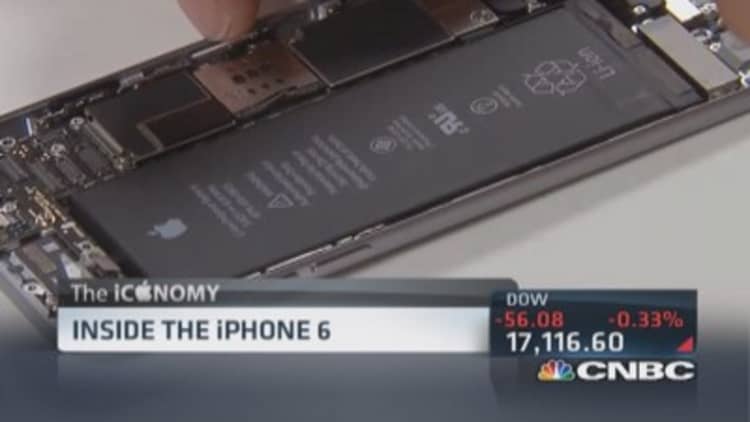
Apple spends $200 to $247 in parts and labor to build an iPhone 6, a teardown analysis of the device due to be released later today shows.
For the larger iPhone 6 Plus, the costs begin at $216 for the starting model and go as high as $263 for the 128 gigabyte model. The estimates by the research firm IHS, shared exclusively with Re/code and CNBC* ahead of release, include the cost of labor associated with assembly as between $4 and $4.50 for each device.
Read More One Apple supplier may not get a pop from the iPhone 6
iPhone 6 models sell for between $649 and $849 without a contract. The iPhone 6 Plus models with the larger display sell for $749 and $949 without a contract.
Apple charges $100 to $200 more for iPhone models with higher memory capacity. But Apple's cost for the additional memory is about $47 more for the 128GB versions than for the 16GB versions.
The result is profit margins that are slightly higher — by about one percent — on the 128GB models than on the 16GB models: About 70 percent for the 128GB models, and about 69 percent for the 16GB models.
Read MoreIPhone 6 in final review stages in China: Tencent
"They seem to be configured and priced to encourage you to buy the models with the higher memory," said Andrew Rassweiler, the IHS analyst who supervised the teardown. He estimates that Apple is paying a price of about 42 cents per gigabyte on the flash memory, which is supplied by numerous companies, including Micron and SK Hynix.
More from Re/code:
Gumi Brings Some New Game Development Stateside
Nearly Half of Apple's Mobile Devices Now Powered by iOS 8
Kickstarter Campaign Aims to Democratize Genome Analysis
The margins are in line with more recent iPhone models but higher than the earliest ones. The gross margin on the iPhone 5, released in 2012, and the iPhone 5s, released last year, were about 69 percent, teardown studies at the time of their release showed. On the lower-priced iPhone 5c, also released in 2012, the gross margin was closer to 68 percent. By comparison, the gross margin on the very first iPhone, released in 2007, was closer to 55 percent.

The most costly component in both phones is the combined display and touchscreen. The displays come from LG Display and Japan Display, costing $45 on the iPhone 6 and $52.50 on the iPhone 6 Plus. The cost for the smaller 4.7-inch model is only four dollars more than the four-inch display used on the iPhone 5s.
Corning held on to its position supplying Apple with its Gorilla Glass to protect the outer layers of the display. Specifically, Rassweiler says the two new iPhones use Gorilla Glass 3, its third-generation product.
There had been some speculation that Apple might instead use sapphire on the display's outer layer, using materials from GT Advanced Technologies. Instead, sapphire is used on the iPhone 6 and 6 Plus to protect the main pushbutton and the primary camera, Rassweiler said. (Apple did opt for sapphire on the display of the Apple Watch.)
Read MoreOff the charts! New iPhone 6 sales smash record
The iPhone's main processor is the A8, designed by Apple. Rassweiler said the processor he saw during the teardown was manufactured by Taiwan Semiconductor Manufacturing, the massive chip-factory-for-hire based in Taipei. TSMC, he said, is one of the few companies with the capability to manufacture 20-nanometer chips.
Apple had previously used South Korea-based Samsung as its chip manufacturer, despite the acrimonious patent litigation between them. The bad blood between them has caused Apple to shift some –but not all — of its production of the chip to TSMC. Rassweiler says TSMC is manufacturing about 60 percent of the chips for Apple, while Samsung is still turning about about 40 percent.

IHS estimates that the A8 processor plus an attached co-processor that handles information from the iPhone's many sensors cost a combined $20, or three dollars more than on the A7-based iPhone 5s. "It has more processing power than the A7, but it's about 13 percent smaller," he says.
Typically, when chips shrink from one manufacturing size to another, they consume less electricity while delivering the same computing power. In this case, Apple added some computing power, too. "Shifting to 20 nanometers is very new and cutting-edge," Rassweiler said. "That Apple has done this while also changing suppliers is a big step."
One new feature of the two iPhones is the addition of near field communications chips that will enable the Apple Pay feature. Chipmaker NXP Semiconductors made the main NFC chip, while a second company, ams AG, made a second one, called an NFC booster, that increases the signal's range and performance. "NXP is pretty much the de facto supplier for all NFC chips used in phones. However, the chip from AMS is one we have never seen used before," Rassweiler said.
Watch: Was Apple late to the game with NFC technology?
The NFC chips were combined in a category that IHS called "user interface and sensors" that added a combined $22 to both phones. Other chips in that category include the audio chip from Cirrus Logic, an accelerometer chip that detects the phone's movement from InvenSense and a second accelerometer from Bosch Sensortec. "We're not sure why the second accelerometer is there," Rassweiler said. "It may be for increased accuracy." Bosch also supplied a barometric sensor for detecting altitude, a feature that hasn't appeared on previous iPhone models, he said.
Other suppliers included chipmakers and Qualcomm, which provided chips for Wi-Fi and Bluetooth and for connecting to the cellular phone network, as well as power management chips to go with them.
Meanwhile, have you ever wondered what a teardown looks like? Glad you asked, because below we have a sped-up video of the iPhone 6 being being disassembled by IHS analysts at the company's lab in El Segundo, Calif. Enjoy.
*CNBC's parent NBCUniversal is an investor in Re/code's parent Revere Digital, and the companies have a content-sharing arrangement.

